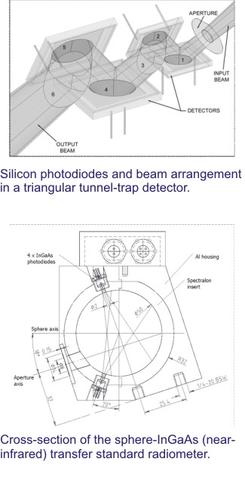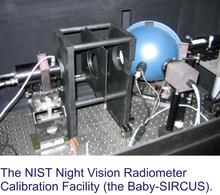Summary
High performance optical radiometers with selected optical detectors are being designed, characterized, and calibrated in the Optical Radiation Group for the 200 nm to 24 µm wavelength range. These radiometers are then converted into standards and used to realize new spectral-responsivity-based scales. New calibration facilities have been developed to realize, maintain, and disseminate these new detector-based scales.
Description

Improved detector technology in the past two decades has opened a new era in detector metrology of optical radiation measurements. Lower calibration and measurement uncertainties can be achieved with modern detector/radiometer standards than traditionally used source standards (blackbodies and lamps). The achievable lower uncertainties provided the motivation to decrease the gap between the 0.02% (k=2) relative expanded uncertainty of cryogenic radiometer measurements and the two to three orders of magnitude higher uncertainties of field-level optical radiation measurements. To lower calibration and measurement uncertainties want to move away from traditionally used source standards (blackbodies and lamps) to modern detector/radiometer standards.
Standard detector/radiometer developments from the ultraviolet to the infrared
To decrease the large measurement-uncertainty gap between cryogenic radiometer measurements (such as those made by the NIST Primary optical watt radiometer) and field measurements, a large variety of transfer and working standard radiometers are being developed. These radiometers are designed to work in different radiometric and photometric measurement modes and satisfy diverse requirements in different scale realizations, scale propagations, and field applications. The radiometers are optically and electronically characterized and verified so that the scale uncertainty is dominated by the scale realization procedure and not by the performance of the radiometers.
For examples, see Transfer and working standard radiometers and photometers.
Detector-based scales
New radiometric, radiance temperature, photometric, and color scales have been realized based on the spectral responsivity of standard detectors and radiometers. These reference responsivity scales have been transferred to other NIST calibration facilities to realize and maintain these detector-based scales and decrease calibration and measurement uncertainties.
Representative papers, published by the Sensor science Division from 1996 to present, have been collected in the NIST Technical Note #1621. These papers describe the conversion of the high-performance optical radiometers into standards and the realization the new improved spectral-responsivity based scales. For more details, see NIST Technical Note 1621: Optical radiation measurements based on detector standards (8 MB pdf).

Night vision goggle calibrations
NIST cooperates with the three services (Air Force, Navy, and Army) to realize a uniform night vision goggle (NVG) calibration system with low measurement uncertainty. These efforts include transferring the NIST detector-based radiance and luminance responsivity scales to the primary standards laboratories, developing radiometric models to estimate uncertainty components in NVG calibrations and field measurements, and standardizing the spectral distribution of the test set of the light sources used in calibrating NVG. In response to these efforts, NIST has developed a night vision radiometer calibration facility and night vision radiometer transfer standards (NVTS). NIST also participates in the work of the Night-vision Sub-committee of the US Department of Defense's Calibration Coordination Group (CCG) to establish a new detector-based NVG gain definition.
For more details, see Uniform calibration of night vision goggles and test sets.
Development of standards for broadband UV measurements
Traditionally used source spectral-distribution or detector spectral-response based standards cannot be applied for accurate UV LED measurements. Since the CIE standardized rectangular-shape spectral response function for UV measurements cannot be realized with small spectral mismatch when using filtered detectors, the UV measurement errors can be several times ten percent or larger. The UV LEDs produce broadband radiation and both their peaks or spectral bandwidths can change significantly. The detectors used for the measurement of these LEDs also have different spectral bandwidths. LEDs with 365 nm peak were applied for fluorescent crack-recognition using liquid penetrant (non-destructive) inspection. The broadband radiometric LED (signal) measurement procedure was standardized. UV LED irradiance-sources were calibrated against an FEL lamp standard to determine its spectral irradiance. The spectral irradiance responsivity of reference UV meters were also calibrated. The output signal of the reference UV meter was calculated from the spectral irradiance of the UV source and the spectral irradiance responsivity of the reference UV meter. From the output signal, both the integrated irradiance (in the reference plane of the reference meter) and the integrated responsivity of the reference meter were determined. Test UV meters calibrated for integrated responsivity against the reference UV meter, were used to determine the integrated irradiance from a field UV source. The obtained 5 % (k=2) measurement uncertainty was decreased when meters with spectral response close to a constant value were selected.
UV-VIS irradiance responsivity scale realization with pyroelectric detector for broadband radiometric measurement of LEDs
Low-NEP pyroelectric detectors with spectrally constant response extended the responsivity of a Si-trap-detector from the visible to 250 nm with an uncertainty of 0.25 % (k=2). The pyroelectric detector was substituted for a Si reference trap-detector in the stable and uniform irradiance of a current and temperature controlled 660 nm LED source. The relative spectral response of the pyroelectric detector (determined from spectral reflectance measurements of the detector coating) was converted into spectral irradiance responsivity. The flatness of the AC measured response function was validated in DC mode against a Si photodiode down to 350 nm. The pyroelectric detector is used as a UV standard for monochromator based calibration facilities and it can also measure the broadband (integrated) irradiance from UV and VIS LEDs.
Major Accomplishments
Spectral irradiance reference scale
The spectral power responsivity scale was extended to a spectral irradiance responsivity reference scale at the SIRCUS (Spectral Irradiance and Radiance Responsivity Calibrations with Uniform Sources) facility. Using this scale, SIRCUS then improved the realization of the SI unit, the candela, which is now directly traceable to the NIST Primary Optical Watt Radiometer (POWR).
Detector-based color scale
Until recently calibrations of tristimulus colorimeters were performed against lamp standards. However, the uncertainty of these source-based calibrations increased with the burning hours of the lamps. These calibrations can now be performed against detector standards, lowering the uncertainty significantly. For more information, see Detector-based color scale.
Radiation temperature scale
Improved transfer- and working-standard radiometers were developed with selected Si, InGaAs, and extended-InGaAs detectors to perform direct thermodynamic temperature measurements over a wide temperature range (420 K to 2700 K) with low uncertainty. This work was done in cooperation of Howard Yoon, project leader of Radiance temperature.
New standard procedures
Broadband LED measurement procedures have been developed to measure/calibrate NVGs and also UV LED irradiance sources. These will be new standards to produce uniform and low uncertainty LED-based measurements in laboratory and field applications.
Development of Infrared Spectral Comparator Facility (IR-SCF)
New calibration facility for calibration the spectral responsivity of different pyroelectric, InSb, InGaAs and some other detectors was created. The new NIST facility allows for responsivity calibrations in both radiant power and irradiance mode in the range from 0.6 µm to 24 µm with an uncertainty of 1 % to 2.5 % (k = 2). Reference detectors include several low NEP pyroelectric detectors, an InSb detector, and a sphere-input extended InGaAs detector. This facility utilizes a high throughput monochromator with six interchangeable diffraction gratings. A blackbody at 1100°C or a quartz halogen lamp. Output optics is designed to create a probe beam or uniform irradiance geometry required for detector calibration. The facility allows also the measurement of the detector noise equivalent parameters, responsivity dependence on the radiation modulation frequency and precise mapping of the detector active area for spatial non-uniformity of response.

